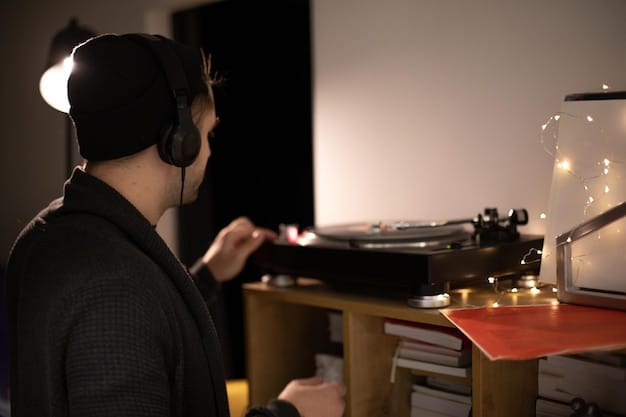ASMR’s Unexpected Comeback in 2025: Exploring the Reasons Why

The Unexpected Resurgence of ASMR in 2025: What’s Driving the Latest Wave? delves into the myriad of factors contributing to the renewed popularity of Autonomous Sensory Meridian Response (ASMR), including technological advancements, shifts in mental wellness trends, and the evolving landscape of online content consumption.
In 2025, the gentle whispers and soothing visuals of Autonomous Sensory Meridian Response, or ASMR, are experiencing an unexpected resurgence. Once a niche corner of the internet, ASMR is captivating audiences again, but what’s driving this latest wave of tingling sensations and relaxed minds?
Decoding the ASMR Phenomenon: What Is It?
ASMR, at its core, is a sensory experience characterized by a tingling sensation that typically begins on the scalp and moves down the back of the neck and upper spine. This sensation is often triggered by specific auditory or visual stimuli, leading to feelings of relaxation and well-being. But why is ASMR specifically making a comeback in 2025?
The Science Behind the Tingles
While scientists are still actively researching the neurological mechanisms behind ASMR, some studies suggest that it may involve the activation of brain regions associated with relaxation, social bonding, and emotional regulation. This neurological response is likely a key component of ASMR’s appeal.
Common ASMR Triggers
ASMR triggers are incredibly diverse but can generally be classified into a few broad categories. Understanding these triggers is essential whether you’re an ASMR creator or simply curious about the experience.
- Whispering: Soft, gentle whispering is one of the most popular ASMR triggers.
- Tapping: Lightly tapping on various surfaces can produce a stimulating sound for many ASMR enthusiasts.
- Visual Triggers: Slow, deliberate hand movements or intricate visual patterns can also induce ASMR.
- Personal Attention: Role-playing scenarios where the ASMR artist provides personal attention can be deeply relaxing.
In conclusion, understanding the basic definition, triggers, and science of ASMR can illuminate why it’s becoming such a mainstream phenomenon once again.
Technological Advances Fueling the Resurgence
Technology plays a pivotal role in ASMR’s revival. Streaming platforms and higher quality audio equipment, accessible to the average consumer, have democratized ASMR content creation. This accessibility, combined with innovative tech enhancements, has significantly contributed to its resurgence.

AI-Enhanced ASMR
Artificial intelligence is making waves in ASMR. AI algorithms are being used to create hyper-realistic soundscapes, enhancing the immersive experience for viewers. This level of detail was hard to achieve previously, but is now possible.
Virtual Reality ASMR
Virtual Reality is another crucial technology amplifying ASMR’s appeal. VR technology creates an immersive experience that intensifies the tingles by combining visual and auditory triggers in a highly realistic digital environment.
To sum up, it is technological advancements such as AI and VR which really contribute to ASMR’s resurgence in 2025, pushing the boundaries of content creation.
Mental Wellness Trends Driving ASMR’s Popularity
In 2025, mental health and wellness are more openly discussed and prioritized than ever before. With the world seemingly in a constant state of flux, people are actively seeking out accessible and effective methods to cope with stress and anxiety. ASMR rises as a perfect candidate.
ASMR as a Stress Reliever
One of the primary drivers behind ASMR’s popularity is its potential as a stress reliever. The calming effects of ASMR can provide a much-needed escape from the daily grind. People use ASMR content to unwind after a stressful day or to help them fall asleep.
The Rise of Self-Care Culture
The self-care movement emphasizes the importance of taking time for oneself and engaging in activities that promote well-being. ASMR fits seamlessly into this culture, offering a convenient and accessible way to practice mindfulness and relaxation.

Ultimately, the integration of ASMR in mental health discussions and its role as a stress-relieving, self-care tool positions it perfectly with cultural trends in 2025, driving its resurgence.
The Evolving Landscape of Online Content Consumption
The way people consume content online has shifted dramatically over the past few years. Short-form videos, personalized content feeds, and a growing demand for authenticity have reshaped the digital landscape. These changes have created the perfect breeding ground for ASMR to flourish.
The TikTok and Instagram Effect
Platforms like TikTok and Instagram have played a significant role in popularizing ASMR. Short, engaging ASMR clips spread rapidly, introducing the phenomenon to new audiences and normalizing it within mainstream content feeds.
Authenticity and Personal Connection
Viewers crave authentic connections with content creators. ASMR artists often foster a sense of intimacy through their content, making viewers feel as though they are receiving personalized attention and care. This personal connection is a key element of ASMR’s appeal.
To encapsulate, changing content consumption patterns and the need for authentic and personal web connections mean that ASMR has risen as a go to platform for soothing comfort in 2025.
ASMR and the Metaverse: A New Frontier?
As the metaverse continues to evolve, it presents exciting opportunities for ASMR content creators and enthusiasts. The immersive nature of the metaverse could amplify the sensory experience of ASMR, creating new avenues for relaxation and engagement. The only thing to be aware of is security in this new internet medium.
Virtual ASMR Experiences
Imagine entering a virtual spa where a digital ASMR artist performs a personalized relaxation session. This is the potential of ASMR in the metaverse. Virtual environments could simulate real-world triggers, enhancing the immersion and effectiveness of ASMR.
Collaborative ASMR Creation
The metaverse could also facilitate collaborative ASMR creation. Artists from around the world could come together in virtual spaces to create unique and innovative ASMR experiences, pushing the boundaries of the medium.
Overall, a new area for ASMR has been built through the Metaverse and VR possibilities, pushing the world forward in online therapy and enjoyment.
The Dark Side of ASMR: Addressing Concerns and Misconceptions
Despite its popularity, ASMR isn’t without its critics and misconceptions. Some view it as strange or even sexual, while others question its legitimacy as a therapeutic tool. Addressing these concerns is crucial for fostering a more informed understanding of ASMR.
Combating Misconceptions
One of the most common misconceptions about ASMR is that it is inherently sexual. While some ASMR content may incorporate suggestive elements, the vast majority is purely focused on relaxation and sensory stimulation. It’s important to debunk this myth and emphasize the non-sexual nature of most ASMR experiences.
Addressing Concerns of Addiction
Some critics worry that ASMR could become addictive, with individuals relying on it as a crutch to cope with stress or anxiety. While it’s possible to become overly dependent on any form of relaxation, ASMR, when used responsibly, can be a valuable tool for managing mental well-being. The key is to promote moderation and balance.
| Key Point | Brief Description |
|---|---|
| 🎧 ASMR Definition | Sensory experience with tingling sensations, helps relax and reduce stress. |
| ✨ Tech Influence | AI and VR improvements are making ASMR a better experience. |
| 🧘 Mental Health | Its rise fits into broader trends on well-being and personal care. |
| 📱 Content Shifts | Consumption patterns are changing, so ASMR uses social media for growth and personal connection. |
Frequently Asked Questions
ASMR stands for Autonomous Sensory Meridian Response. It represents a pleasurable tingling sensation that commences on the scalp and spreads down the neck and upper spine, often in response to specific auditory or visual stimuli.
Yes, ASMR has shown potential in relieving stress. Scientific studies have suggested that experiencing ASMR may activate areas of the brain associated with relaxation, social engagement, and emotion regulation, hence reducing stress levels.
Yes, virtual reality could possibly greatly enhance the ASMR experience because it can provide a more sensory experience compared to what is normally seen and create new routes for people to engage and experience ASMR.
Short, engaging ASMR clips on TikTok rapidly expose the occurrence to diverse audiences and integrate it into mainstream content flows. Platforms like TikTok and Instagram have normalized and are assisting its popularity.
Most content focuses on relaxation and sensory stimulation, though some ASMR content might include suggestive elements. It’s important to emphasize that ASMR experiences are largely non-sexual, and it is often used for relaxation.
Conclusion
The resurgence of ASMR in 2025 is a multifaceted phenomenon driven by technological innovation, evolving mental wellness trends, and the changing landscape of online content consumption. As ASMR continues to evolve and adapt to new technologies, it may well become an even more integral part of our digital lives, offering comfort, relaxation, and a sense of connection in an increasingly chaotic world.





